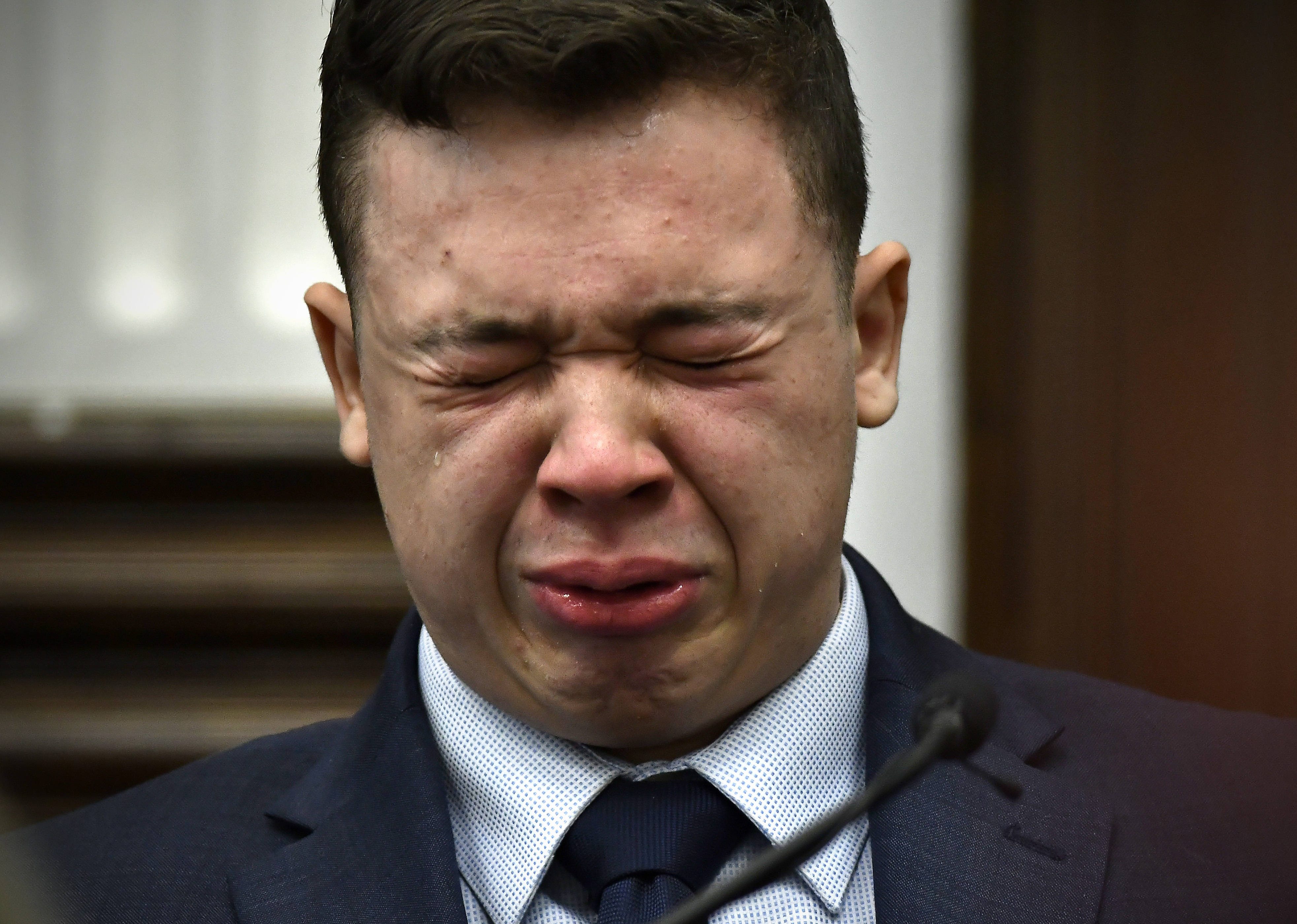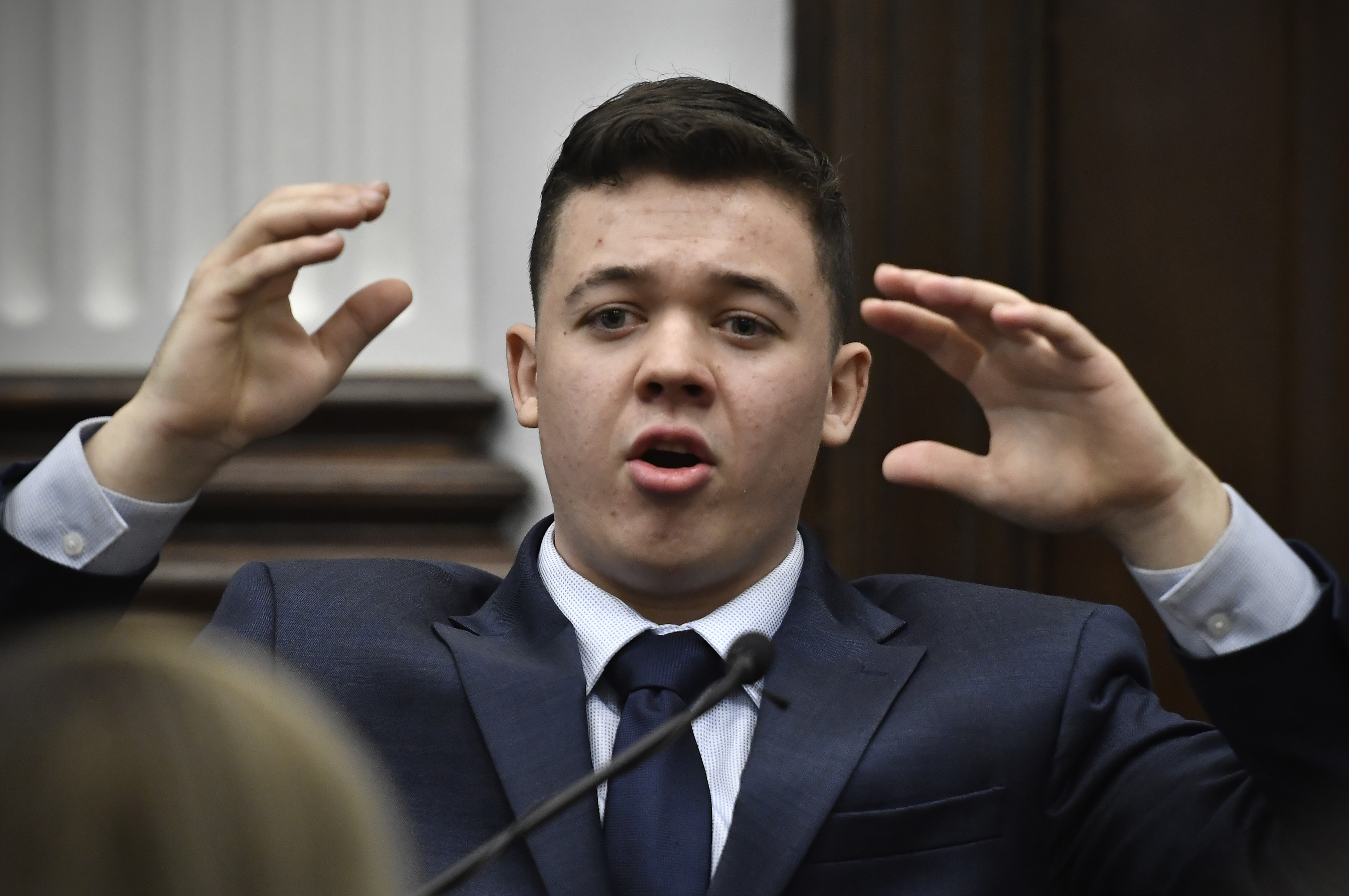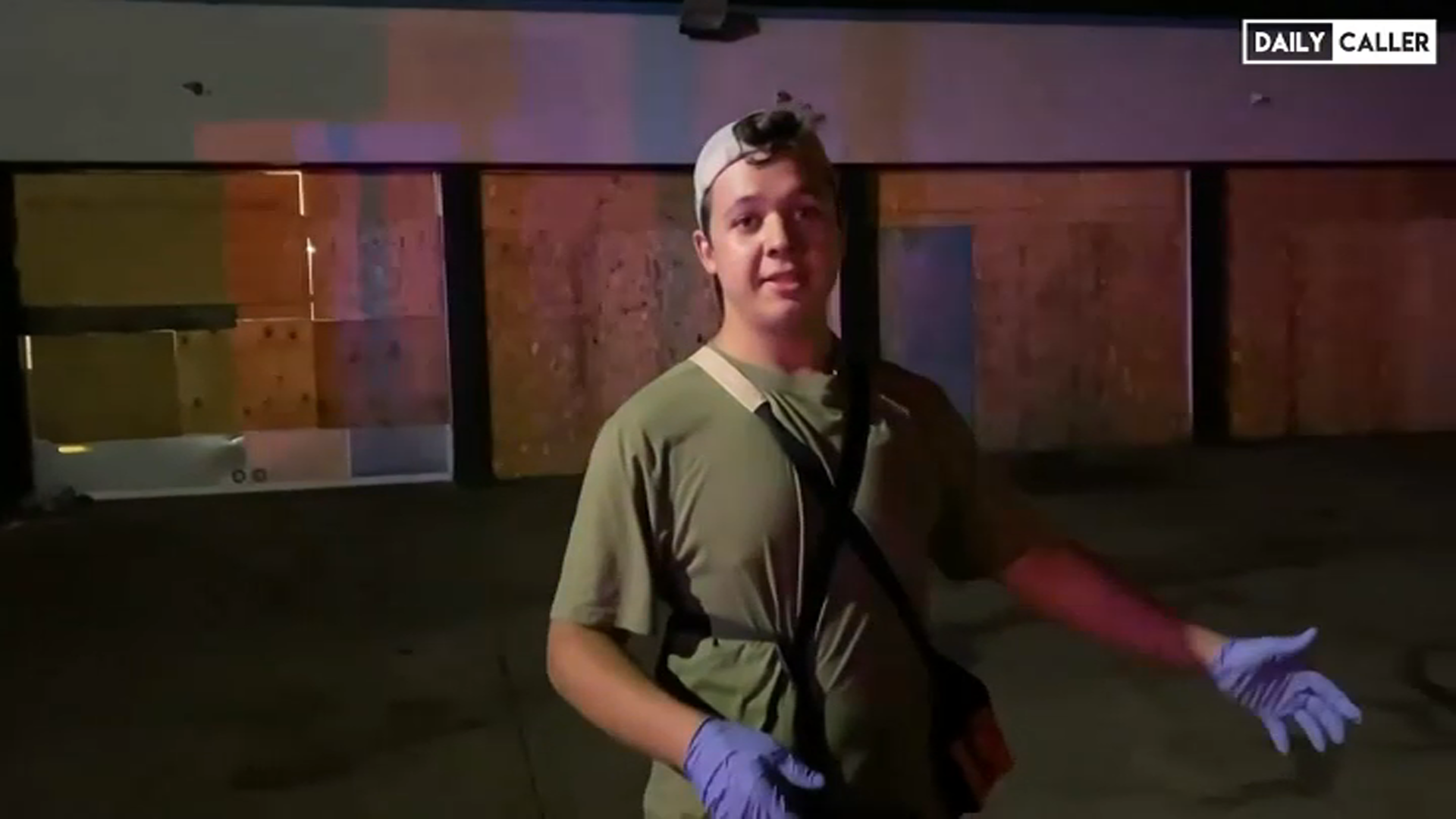BREAKING: A jury has found Kyle Rittenhouse not guilty on all counts in his murder trial connected to the shootings of three people during unrest in Kenosha during the summer of 2020. Details here.
_________________________________________________________________________
On the night of Aug. 25, 2020, Kyle Rittenhouse went from being described as a 17-year-old police enthusiast to a teenage gunman accused of shooting three people, two of them fatally.
His story became the center of bitter nationwide divisions on issues of guns, protests and policing. Soon, his fate will be in the hands of a jury.
So what exactly happened? Here's a look back at how the case began and where it has gone since.
An Overview of What Happened
Rittenhouse, 17 at the time, traveled the few miles from his home across the state border to Kenosha on Aug. 25, 2020, as the city was in the throes of damaging protests that followed a white police officer's shooting of Jacob Blake, a Black man, after a call to a domestic disturbance.
Bystander video captured the critical minutes when Rittenhouse, with a Smith and Wesson AR-style semiautomatic rifle, shot and killed Joseph Rosenbaum, 36, and Anthony Huber, 26, and wounded Gaige Grosskreutz, 28.
Kenosha County Sheriff David Beth said people believed to be in a "militia" or "vigilante group" had been patrolling the streets at night. Rittenhouse appeared in several videos alongside those groups.
Before the shooting, the conservative website The Daily Caller conducted a video interview with Rittenhouse in front of a boarded-up business.
Feeling out of the loop? We'll catch you up on the Chicago news you need to know. Sign up for the weekly Chicago Catch-Up newsletter.
“So people are getting injured, and our job is to protect this business,” the young man said. “And part of my job is to also help people. If there is somebody hurt, I’m running into harm’s way. That’s why I have my rifle — because I can protect myself, obviously. But I also have my med kit.”
Rittenhouse has argued self-defense in the shootings. Prosecutors trying to convict him of murder have been working to paint him as an inexperienced teenager who misrepresented his age and medical training to other armed civilians in his group on the night of the shooting.
Rittenhouse is white, as are the three men he shot. The case raised questions about racial justice, policing, firearms and white privilege that polarized people far outside Kenosha.
A Breakdown of the Moments the Shooting Unfolded
Screams were heard as gunshots rang out in the streets of Kenosha late at night on Aug. 25, 2020, leaving two people dead and a third hospitalized as protesters appeared to rush an alleged gunman.
Video posted to social media showed shots ringing out in the street before a man was discovered with a gunshot wound to the head. Witnesses were seen carrying that man to a hospital.
In a separate scene, a group of protesters were heard following a man, later identified as Rittenhouse, shouting "Why'd you shoot him."
Moments later, video taken by a photographer at a nearby scene showed Rittenhouse, armed with an AR-15-style semiautomatic rifle, sitting on the ground and opening fire into the crowd around him. A man in the crowd was shot in the arm. A third man was seen in the footage unmoving on the ground before authorities arrive and carry him away.
Photos that also captured that shooting appeared to show a man kicking Rittenhouse before another man with a skateboard appears to grab the teen's weapon. The man with the skateboard was the same man seen lying on the ground not moving in the video.
A witness, Julio Rosas, 24, said that when the gunman stumbled, "two people jumped onto him and there was a struggle for control of his rifle. At that point during the struggle, he just began to fire multiple rounds, and that dispersed people near him.”
“The rifle was being jerked around in all directions while it was being fired,” Rosas said.
Photos: Images Show Traumatic Scene as Gunfire Erupts in Kenosha During Another Night of Unrest
Authorities confirmed three people were shot, two fatally, as unrest gripped the Wisconsin city for the third straight night following the police shooting of Jacob Blake.
The two people killed were identified as 36-year-old Joseph Rosenbaum, of Kenosha, and 26-year-old Anthony Huber, of Silver Lake. Gaige Grosskreutz, 27, a protester from West Allis, Wisconsin, was wounded.
Huber was the man seen swinging a skateboard at Rittenhouse before he was shot. Grosskreutz had a gun in his hand as he stepped toward Rittenhouse and was shot.
In the moments after the shooting, Rittenhouse walked toward police with his hands in the air, yet he was not arrested.
What Charges Does He Face?
Rittenhouse faces multiple charges. The homicide charges include one count of reckless homicide, one count of intentional homicide and one of attempted intentional homicide. A legal expert says the difference in the charges is that prosecutors aren't alleging that Rittenhouse intended to kill the first man he shot. But the charges in the other two shootings allege that Rittenhouse intended to shoot those men.
Who Are the Victims?
The two people killed were identified as 36-year-old Joseph Rosenbaum, of Kenosha, and 26-year-old Anthony Huber, of Silver Lake, Wisconsin.
Gaige Grosskreutz, 27, a protester from West Allis, was wounded.
Rosenbaum, 36, was released the day of the shootings from a Milwaukee hospital where he had been treated for a suicide attempt. It’s not clear why he was on Kenosha’s streets the night of the protests, though he had a fiancé who lived in the city. His background includes a conviction for sexual conduct with a minor in Arizona in 2002. The judge denied a defense request to argue that Rosenbaum was trying to get Rittenhouse’s rifle because, as a convicted sex offender, Rosenbaum couldn’t legally get one on his own.
Huber is seen on video swinging a skateboard at Rittenhouse before he was shot. He was known around Kenosha’s skateboarding community, and his girlfriend, Hannah Gittings, said skateboarding was his life. Huber served a pair of prison stints stemming from family conflict, including choking his brother in 2012.
A great-aunt, Susan Hughes, said Huber was involved in protests because he was “very upset” that a police officer had shot Blake, who was left paralyzed from the waist down.
Grosskreutz previously said he attended several protests following Floyd’s May 2020 death. With training as a paramedic, Grosskreutz had carried medical supplies and was doing so the night of the Kenosha shootings.
He was also armed with a pistol and had it in his hand when he approached Rittenhouse, who shot him in the arm.
On the stand, Grosskreutz said he confronted a rifle-toting Rittenhouse with a gun of his own to try to stop the bloodshed.
When asked what was going through his mind as he neared Rittenhouse, the 27-year-old testified, “That I was going to die.”
Who is Kyle Rittenhouse?
Rittenhouse, of Antioch, was 17 at the time of the shootings.
He was an ardent police supporter before the incidents, serving as a youth cadet in the Grayslake Police Department and posting photos of himself brandishing a rifle above the caption “Blue Lives Matter.” He worked part-time as a YMCA lifeguard in Lindenhurst before he was furloughed in March 2020.
He traveled to Kenosha, which is only about 15 miles from his home, on Aug. 25 after pleas went out on social media to protect businesses during protests over the shooting of a Black man, Blake, by a white police officer two days earlier. Video from the night of the shootings shows Rittenhouse on the streets with his AR-style semiautomatic rifle and a medical kit slung over his shoulder.
“People are getting injured and our job is to protect this business,” Rittenhouse told a reporter from the Daily Caller before the shootings. “And part of my job is to also help people. If there is somebody hurt, I’m running into harm’s way. That’s why I have my rifle.”
As conservatives rallied to Rittenhouse as a symbol of gun rights and resistance to the sometimes damaging protests that followed George Floyd’s death in Minneapolis, he has seemed at times to revel in his notoriety. He posed for photos in a Wisconsin bar with members of the far right extremist group the Proud Boys, though his attorneys say there’s no evidence he was affiliated with the group before the shootings.
High-Profile Donations
Former child actor Ricky Schroder and MyPillow CEO Mike Lindell were among those who contributed to a bail fund for Rittenhouse in November 2020.
Both played key roles in "putting us over the top" in coming up with $2 million for bail, Rittenhouse's former defense attorney Lin Wood said.
Schroder is a noted Hollywood conservative, while Lindell is vocal supporter of former president Donald Trump.
The Prosecution's Case Against Rittenhouse
Rittenhouse has argued that he shot the men in self-defense. That means his attorneys must persuade jurors that he reasonably believed his life was in danger and that the amount of force he used was reasonable.
Prosecutors trying to convict Rittenhouse of murder have been working to paint him as an inexperienced teenager who misrepresented his age and medical training to other armed civilians in his group on the night of the shooting.
The lead prosecutor, Kenosha County Assistant District Attorney Thomas Binger, maintains that Rittenhouse was the aggressor and overreacted to the situation.
Binger drew out testimony during the first week of the trial from several witnesses, including two military veterans, saying the Illinois teen appeared inexperienced, that he falsely claimed that he was old enough to possess a gun and that he was a certified medic when he was really just a lifeguard.
Prosecutors have described Rittenhouse as a vigilante and a “chaos tourist” with a violent streak.
They unsuccessfully sought to introduce a pair of videos, including one that showed Rittenhouse appearing to punch a girl who was fighting his sister a couple of months before the shootings, and another in which Rittenhouse is heard commenting that he would like to shoot some men he thought were shoplifting from a pharmacy.
Binger began his closing remarks telling the jury, “I think we can all agree, we shouldn’t have 17-year-olds running around with AR-15s, because this is what happens."
“When the defendant provokes the incident, he loses the right to self defense,” he said. “You cannot claim self defense over a danger you create.”
The Defense's Arguments
Attorneys spent the first week of the murder trial sparring over who provoked whom, with prosecutors portraying the teenager as the aggressor and the defense working to show that the men he shot had threatened him.
The stakes are enormous as jurors weigh whether Rittenhouse fired in self-defense because he legitimately felt threatened or whether he overreacted.
“To establish self-defense, the first prong is the defense must show there was going to be interference with Rittenhouse and that Rittenhouse had a belief that could result in great bodily harm,” said former Milwaukee County prosecutor Daniel Adams, who isn’t involved in the case.
Rittenhouse insists he fired in self-defense in all three instances.
Mark Richards, Rittenhouse's defense attorney, also has worked to persuade the jury that Rosenbaum was a menace. He got a police detective to testify that at various points during the night, Rosenbaum armed himself with a chain he stole from a construction site, set a dumpster on fire and was walking around wearing his shirt as a mask.
Ryan Balch, a military veteran who carried a rifle and was with Rittenhouse at points, testified that Rosenbaum was “hyperaggressive,” had thrown rocks at his group and had threatened to kill “any of you guys” that he found alone that night. But another former veteran who was armed in the streets, Jason Lackowski, described Rosenbaum as a “babbling idiot” whom he didn’t see as a threat.
Richard McGinniss, a video journalist with the conservative website The Daily Caller who was recording events that night, testified that Rosenbaum chased Rittenhouse down and lunged for Rittenhouse’s rifle.
Richards also noted in his opening statement that Grosskreutz was carrying a handgun when he approached Rittenhouse.
“What he’s trying to do is put the jury in the shoes of Rittenhouse (and show) that the dread, the fear and the terror is real,” Adams said. “When you’re being attacked by several people, he doesn’t know (their intentions). What he thinks is he’s going to get his gun stripped off and used against him.”
Binger, the prosecutor, has pushed back, stressing repeatedly that Rosenbaum was unarmed when he was killed. He also has argued that Rittenhouse provoked Rosenbaum during a confrontation earlier that evening and that Rittenhouse chased him with a fire extinguisher before Rosenbaum turned the tables.
He got Balch to acknowledge on the stand that he never saw Rosenbaum strike anyone or carry a weapon. Binger also questioned McGinniss’ description of Rosenbaum lunging toward Rittenhouse, raising the prospect that Rosenbaum was actually falling toward him — as McGinniss had said in a televised interview after the shootings.
Binger also has argued that Huber and Grosskreutz were trying to disarm Rittenhouse to protect others. He has said that Grosskreutz raised his hands in a universal “surrender” motion before he was shot. Richards maintains he dropped his hands and began to raise his pistol.
Major Trial Developments: Rittenhouse Testimony, Juror Dismissed, Calls for Mistrial
An effort by prosecutors to portray one of the men Rittenhouse shot as a hero never got off the ground.
Huber's great-aunt, Susan Hughes, was testifying about Huber in a matter-of-fact manner, talking about their relationship, how he ended up at the protest and how he always carried a skateboard.
Then prosecutor James Kraus posed a question: “We’ve seen video here, and you may have seen video as well, that Anthony Huber ran towards Kyle Rittenhouse while Kyle Rittenhouse was armed. Were you surprised, when you heard about that? Were you surprised by his actions?”
As defense attorney Corey Chirafisi swiftly objected, Kraus posed another: “Had you ever seen Anthony Huber run towards danger?”
Hughes said, “Yes,” before Chirafisi objected again and testimony was stopped.
Meanwhile, a juror in the murder trial was dismissed after a court security officer reported that the man told a joke about the police shooting of Blake, which set off protests in the Wisconsin city.
The judge presiding over the trial said the security officer reported the remarks last week. Binger, the lead prosecutor, said the remarks as shared showed racial bias.
One of the most the riveting moments came when 18-year-old Rittenhouse told the jury that he was defending himself from attack when he used his rifle to kill two men and wound a third on the streets of Kenosha in the summer of 2020.
Rittenhouse testified he fatally shot Rosenbaum after Rosenbaum chased him and put his hand on the barrel of Rittenhouse's rifle. He said he then shot and killed Huber after Huber struck him in the neck with his skateboard and grabbed his gun.
When a third man, Grosskreutz, “lunges at me with his pistol pointed directly at my head,” Rittenhouse shot him, too, wounding him.
Rittenhouse cried as he described how Rosenbaum chased him.
As he began crying on the stand and appeared unable to speak, his mother, Wendy Rittenhouse, on a bench across the courtroom, sobbed loudly. Someone next to her put an arm around her. After the judge called a recess, jurors walked by Rittenhouse and looked on as he continued to cry.
Once his testimony resumed, Rittenhouse mostly kept his composure as he spent hours fielding questions from his attorneys and prosecutors.
The murder case against Rittenhouse was thrown into jeopardy when his lawyers asked for a mistrial over what appeared to be out-of-bounds questions asked of Rittenhouse by the chief prosecutor.
Rittenhouse attorney Mark Richards suggested Binger might be attempting to provoke a mistrial. The defense asked for a mistrial with prejudice, meaning that if it is granted, Rittenhouse cannot be retried in the shootings.
Judge Schroeder did not immediately rule on the request but was clearly angry at the prosecution, telling Binger: “When you say that that you were acting in good faith, I don’t believe that.”
Attorneys also sparred over the technology used to zoom in on video and create enlarged images, with prosecutors alleging the defense was taking advantage of the 75-year-old judge's admitted lack of understanding about current technology.
“I will tell you that I totally agree with your comment about my lack of familiarity with these concepts,” Schroeder told the attorneys without the jury present. “This is a difficult concept for me, yes.”
In both cases, prosecutors were arguing for enlarging key images on the night last summer that Rittenhouse shot and killed two protesters and injured a third on the streets of Kenosha. Much of the action that night was captured on sometimes hard-to-decipher cellphone video, as well as by a drone.





